17.01.2022
Can cats eat grapes? Why is this fruit concerning for cat parents?
As much as cat parents love to share their food with their furry friends, this practice comes with several risks. Most human food is off the table for felines because it’s toxic or causes stomach upsets. Are grapes on that list?
Untamed answers the following questions:
- Can cats eat grapes?
- What happens if they do?
- Are grapes toxic to cats?
- Can cats eat raisins?
- Why would cats eat grapes?
- What should cats eat instead?
- Are there other products felines shouldn't eat?
- What are safer treats?
What happens when a cat eats grapes?
Grapes are toxic to cats. If a feline eats the fruit, symptoms of toxicosis will manifest 6–12 hours after ingestion, including:
|
Typical symptoms |
Severe toxicosis |
|
|
Complete kidney failure happens three days later, and when they stop producing urine, the chances of survival are minimal.
The good news is that the condition is reversible. Symptoms of acute kidney failure occur within 24 hours after the ingestion of grapes, so your cat is likely to recover if you take them to a veterinarian immediately.
What should I do if my cat eats grapes?
If you notice any of the above-listed symptoms or catch your cat eating grapes, you must:
- Take them to the veterinarian—The sooner your cat receives the treatment, the better the chances for a full recovery. Don't wait for the symptoms to pass because they will only worsen
- Call the Animal PoisonLine (APL) and ask for assistance (if you can’t reach your or any other vet in the area)—Veterinary poisoning specialists are ready to determine whether your cat needs treatment. The number of the Animal PoisonLine is 01202 509000
Keep in mind that you can’t treat this condition yourself. Only a vet can administer appropriate treatment.
Treating grape poisoning in cats
To determine a cat’s medical condition after eating grapes, a veterinarian will check their blood and monitor their kidneys for 72 hours. Intravenous (IV) fluids are often administered to help rehydrate cats and induce diuresis—a process in which kidneys make extra urine to get rid of a harmful substance.
If, after 72 hours, a cat doesn’t show signs of kidney damage, they’re likely to recover completely.
Why are grapes toxic to cats?
The real reason grapes are toxic to cats is still unknown. Veterinarians suspect that the culprits are:
- Mycotoxins (fungal toxins)—Some of these toxins are known to cause kidney damage in mammals
- The salicylate content of grapes—Specialists are investigating whether the salicylate content can reduce blood flow to the kidneys
- Tartaric acid—It is the most plausible reason for the toxicity of grapes. The Animal Poison Control Center (ASPCA) is conducting studies on the impact of tartaric acid on cats because some homemade playdough recipes (also considered toxic to pets for multiple reasons) contain tartar cream

Why are my parents obsessed with these soft orbs on a branch?
Source: atomu0207
Can cats eat raisins?
Raisins are equally toxic to felines because they contain everything grapes do (minus the water content). The bad news is that raisins are even more dangerous.
Let’s compare the sugar content in grapes and raisins:
|
Item |
Amount of sugar per 100 grams of food (approximate values) |
|
Grapes (all variants) |
16 grams |
|
Raisins |
59 grams |
The crystallisation of glucose and fructose increases the sugar content in raisins. To make matters worse, some manufacturers add sugar to raisins during dehydration to enhance their taste. Cats don’t need sugar, and ingesting it can only cause gastrointestinal problems such as nausea, vomiting, diarrhoea, and abdominal pain. Long-term use can lead to feline diabetes.

What is mum making? I bet she put raisins in so I can’t steal her food again!
Source: Freepik
What about grape juice and other products containing grapes and raisins?
You should avoid giving your cat any foods or drinks containing grapes or raisins, including:
- Fruit salads
- Smoothies
- Grape juice (which often contains added sugar and artificial colouring and flavouring)
- Raisin cookies
- Bread containing raisins or grape juice
- Energy bars containing raisin paste
Even one grape or raisin is enough to cause severe toxicosis. Toxicity aside, cats are obligate carnivores, and their digestive system isn’t designed to process and absorb nutrients from plants anyway.

If I can’t get any of that food, mum won’t, either!
Source: Pexels
Do cats like grapes?
There is no particular reason for cats to crave grapes. They might like the soft and moist texture of the fruit, but cats lack receptors for sweetness, so the sugar content in grapes isn’t why they’re munching on the fruit.
Your furry friend could show interest in grapes if they are hungry for a long time or might lick the grape juice in the fruit if they get thirsty. Cats typically aren’t drawn to any kind of fruit.
Acceptable treats for your little carnivore
Before you go treat shopping, learn about:
- The basics of healthy feline nutrition
- Deciphering cat food labels
What do cats eat?
Cats thrive on lean meats, fish, and crustaceans with more than 50% protein and up to 20% fat. Protein contains amino acids that fuel all your cat’s metabolic processes, taurine and arginine being the most important ones.
Some of the feline favourites include:
- Chicken
- Turkey
- Duck
- Sardines
- Shrimp
- Tuna
- Prawns
- Mackerel
- Salmon
The feline digestive system is designed to process meat, so other products are unnecessary for cats. Meat is also super tasty to cats.
How much food do cats need?
On average, cats need 40–45 calories per kilogram of healthy body weight. The recommended daily food intake for an average-sized cat (3.8 kg–6 kg) is 152–270 calories. The exact amount of food your cat needs depends on their:
- Life stage—Kittens need more calories than an average adult cat to support their rapid growth. Senior cats eat 20–30% less than adult cats (unless they are geriatric, in which case a caloric increase is introduced to help the feline maintain a normal physique)
- Breed—Maine Coons eat significantly more than Siamese because of their size
- Reproductive capabilities—Neutered or spayed cats require fewer calories in a day than intact felines
The problem with commercial cat food
Pet stores are stacked with treats, but how to recognise the best ones for your cat? The main issue with commercial products is that they typically contain:
- Plant proteins—Cats can’t utilise these nutrients because they don’t produce the enzymes necessary to break them
- Various chemicals (for example, preservatives and taste enhancers)—These are typically used to preserve the product and add some taste to low-quality products. Some artificial additives are thought to cause cancer in cats, so the less iffy chemical ingredients, the better
- Meat derivatives—The best meat cuts are typically used in the human food industry, leaving leftovers to cat food manufacturers. Meat derivatives can be anything from real meat to slaughterhouse scraps, so choose products with a precisely stated protein source
- Cat food labels explained
To help you avoid harmful ingredients and pick the best cat food, here is an explanation of commonly used terms on cat food labels:
|
Term |
The product |
|
Contains no additives or synthetic ingredients and wasn’t subjected to chemical processing |
|
|
Organic |
Contains no artificial flavourings or ingredients from genetically modified organisms and is subjected to special, harmless cleaning materials and pest control methods |
|
Complete |
Is legally bound to contain all nutrients that are essential for cats (in necessary amounts) |
|
Fresh |
Can only be refrigerated and not be subjected to any shelf-life-prolonging materials or processing |
What are good treats for cats?
Cats should eat wet food (gravy and jelly) as regular meals. Dry food is also an option, but the biscuits should be mixed with wet food because they are usually heavily processed and lack moisture.
Lean deli meats (such as ham) work as a treat if served in tiny bits because of their sodium content.
Cooked liver is rich in nutrients, so rich that more than a bite-sized piece could cause hypervitaminosis A, so serve it in moderation.
The best snacks are meats your kitty typically doesn’t eat, such as cooked beef or pork. Keep in mind that beef is a common allergen, so monitor your cat after giving it.
Keep treats under 10% of your cat’s daily food intake to prevent weight gain and other health problems.
Untamed—tasty and nutritionally complete food
Cats won't munch on unknown items if their regular food is complete and tasty. The Untamed mission is to ethically produce delicious, high-quality cat food to keep your furry friend happy and healthy throughout all stages of life (kitten, adult, and senior). Even finicky cats love Untamed!
To achieve that, we:
- Use sustainably farmed human-grade meat
- Follow vet-formulated recipes
- Gently steam the ingredients to eliminate the bacteria and keep natural juices and aromas
- Run our operations by leaving a neutral carbon footprint
If you want to treat your feline to irresistible cat food with double the protein compared to the industry standard, order our taster pack!
Treat your cat to Untamed delicacies
To tailor-make a meal plan for your kitty, you should:
- Visit our Try Now page
- Complete a short questionnaire
- Pick a meal plan and place your order
Our trial cat food box will last you a week. You can then finalize your cat food subscription with us—you get consistent monthly deliveries with free shipping and can tweak your orders anytime.

One, two, three… There are so many! And all for me?
Image (c) Untamed
Health benefits of switching to Untamed
Untamed works for cats of all breeds, including Persians, Bengals, Siamese, Ragdolls, Maine Coons, and British Shorthair.
Our recipes follow the essential dietary needs of felines and have no additives, grains, sugar, vegetables, or fruits added. With no common allergens as ingredients, Untamed food is perfect for sensitive cats. If your cat is prone to allergies, they can try our single-protein-source products—Chocka Chicken and Tuck-in Tuna.
According to the feedback we got from happy cat parents, you should see the following changes in your cat after switching to Untamed:
|
Time |
Changes |
|
One week |
|
|
Two months |
|
|
Four months |
|
|
For life |
|
Our products require no extra prep (nope, no defrosting or extra cooking). All you need to do is open the tin, and you’re good to go!

What do you mean by “those are only for photo shooting purposes”?
Image (c) Untamed
Does your cat reject food (wet or dry), eat only products from a particular brand, or have an inconsistent meal schedule?
Untamed can help you with:
- Reigniting your cat’s love for food
- Transitioning from one type of food to another
- Weaning your kitten off milk
- Adding moisture to your cat’s food (like water, soup, or broth, but yummier)
Are all human foods forbidden?
Most plant-based products aren’t harmful to your cat, but they can’t replace meat, so a vegan diet is inadequate for cats.
On occasion, your kitty can handle a tiny portion of:
|
Fruits |
Vegetables |
Grains |
|
|
|
Keep in mind that these items are only safe if you:
- Wash them thoroughly
- Remove the pits, skin, seeds, stems, and leaves
- Cut them into tiny bits
- Make sure they calorically don’t exceed 10% of your cat’s daily calorie intake
Some items (such as corn) are known to cause severe allergic reactions in cats, so make sure to monitor your cat for any symptoms of food allergies after offering them a treat.
Check out our other guides to what cats can or cannot eat:
|
|
More foods that are toxic to cats
Grapes aren’t the only food you must keep away from your furry friend.
Never give your furry companion the following:
- Products containing cocoa powder—Chocolate might seem like a good treat after dinner, but the theobromine and caffeine in cocoa powder are life-threatening to cats
- Coffee—Also contains caffeine and can lead to hyperactivity and poisoning
- Alcohol—Ethanol causes the feline nervous system to malfunction, leading to ataxia, loss of coordination, drops in blood pressure and blood sugar, loss of consciousness, coma, and eventually, death
- Allium vegetables—Cause oxidative damage in red blood cells, which leads to rupture. Erythrocytes transport oxygen through the body, so when they’re gone, a life-threatening condition called hemolytic anaemia occurs
- Citrus fruits—The citric acid and essential oils can cause tremors, seizures, and even death
- Yeast—The fermentation of yeast produces ethanol and carbon dioxide, which cause ataxia, disorientation, and severe bloating (gastric dilatation-volvulus). Both ethanol poisoning and GDV can be lethal
Foods that aren’t toxic to cats but should still be avoided
Being obligate carnivores, cats are sensitive to many human foods, such as:
- Dairy products (for example, cheese) and any kind of milk—When drinking milk, cats can experience various health problems, such as abdominal pain, vomiting, and diarrhoea. Felines don’t produce the enzyme (lactase) necessary to break down lactose into digestible sugars. Lactose-free products are also bad for cats because they are not nutritionally fit for carnivorous creatures and cause stomach upsets. Tiny portions of yoghurt can work as a treat
- Coconut flesh and water—Coconuts have a high concentration of oil that causes loose stools and gastrointestinal issues
- Eggs (raw or cooked)—Raw eggs can contain bacteria and obstruct vitamin B7 absorption. Eggs are also high in calories, so avoid them altogether
- Raw and undercooked fish and meat—Raw chicken might seem like a healthy treat for your kitty, but you should never give raw food to your cat before consulting a veterinarian. Raw meat requires special serving and preservation methods to avoid contamination with bacteria, such as E. coli and Salmonella
- Fat trimmings—Cooked or raw, fat trimmings raise the level of lipids in your cat’s blood and cause a condition called pancreatitis (inflammation of the pancreas)
How to prevent your sneaky feline from reaching your favourite food
Cats can be up to all kinds of playful mischief, and stealing their parents’ food is a pretty popular activity.
To keep the dangerous ingredients safe, you should:
- Lock cabinets
- Store food in airtight containers
- Lock the kitchen door or mount a heavy sliding door
- Keep fruit in the fridge instead of displaying it on the table

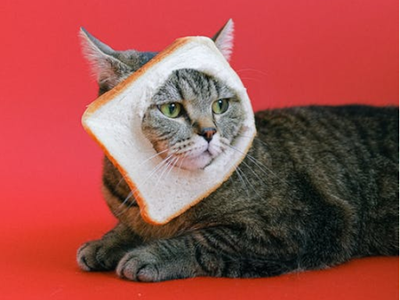
![Associated image for Best food for Ragdoll cats in the UK [Broken Down]](http://untamed.com/cdn/shop/articles/featured_best_food_for_ragdoll_cats_uk_400x300_crop_center.jpg?v=1646818249)
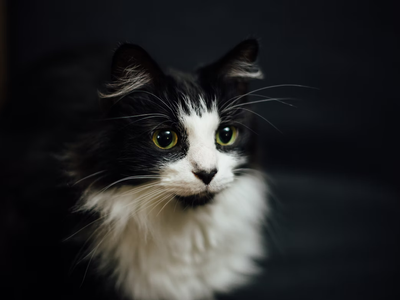
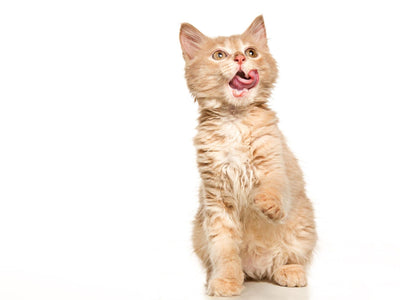

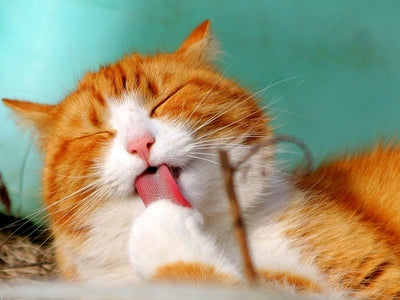
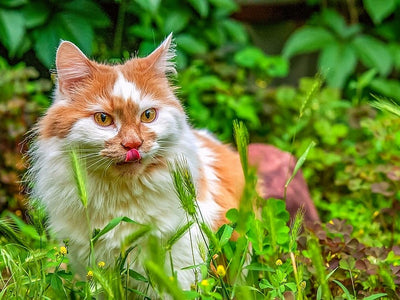

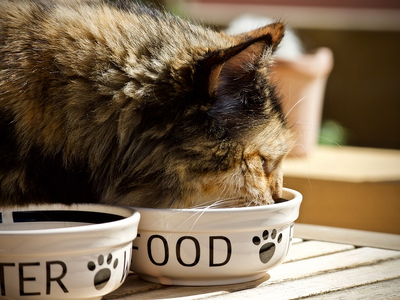
![Associated image for What human food can Sphynx cats eat? [Comprehensive list]](http://untamed.com/cdn/shop/articles/what_human_food_can_sphynx_cats_eat_Featured_400x300_crop_center.jpg?v=1648705074)

